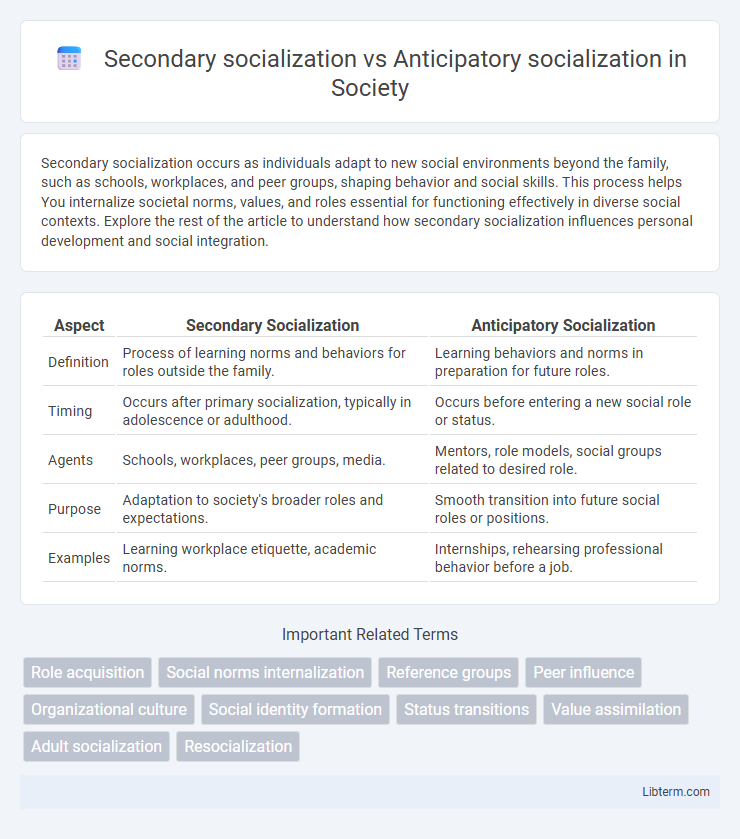Secondary socialization occurs as individuals adapt to new social environments beyond the family, such as schools, workplaces, and peer groups, shaping behavior and social skills. This process helps You internalize societal norms, values, and roles essential for functioning effectively in diverse social contexts. Explore the rest of the article to understand how secondary socialization influences personal development and social integration.
Table of Comparison
| Aspect | Secondary Socialization | Anticipatory Socialization |
|---|---|---|
| Definition | Process of learning norms and behaviors for roles outside the family. | Learning behaviors and norms in preparation for future roles. |
| Timing | Occurs after primary socialization, typically in adolescence or adulthood. | Occurs before entering a new social role or status. |
| Agents | Schools, workplaces, peer groups, media. | Mentors, role models, social groups related to desired role. |
| Purpose | Adaptation to society's broader roles and expectations. | Smooth transition into future social roles or positions. |
| Examples | Learning workplace etiquette, academic norms. | Internships, rehearsing professional behavior before a job. |
Introduction to Socialization
Secondary socialization involves the process through which individuals learn appropriate behaviors and norms within specific social institutions such as schools, workplaces, or peer groups, following primary socialization in the family. Anticipatory socialization prepares individuals for future roles and expectations by adopting behaviors and attitudes aligned with a different social status or group they aim to join. Both forms of socialization play crucial roles in the introduction to socialization by shaping individuals' ability to navigate and integrate into diverse social environments effectively.
Defining Secondary Socialization
Secondary socialization refers to the process through which individuals learn appropriate behaviors, norms, and values outside their primary family environment, typically occurring in schools, workplaces, and peer groups. This phase builds on primary socialization by adapting individuals to broader societal roles and expectations. Unlike anticipatory socialization, which prepares individuals for future roles, secondary socialization involves the ongoing acquisition of skills and norms necessary for functioning effectively in adult social settings.
Understanding Anticipatory Socialization
Anticipatory socialization involves individuals adopting behaviors, values, and norms of a group they aspire to join, facilitating smoother integration into future roles or social settings. Unlike secondary socialization, which occurs when individuals learn appropriate behaviors within an already established social environment, anticipatory socialization is proactive and future-oriented. This process plays a critical role in preparing individuals for occupational roles, cultural integration, and social expectations in advanced stages of life.
Key Differences Between Secondary and Anticipatory Socialization
Secondary socialization occurs when individuals learn appropriate behaviors and norms within new social environments outside the family, such as schools or workplaces, shaping their social roles over time. Anticipatory socialization involves adopting behaviors, values, and attitudes of a group or role one aspires to join, preparing for future positions or statuses in advance. Key differences include the timing and purpose: secondary socialization is reactive and ongoing in established roles, while anticipatory socialization is proactive, focused on future integration into new social contexts.
Agents Influencing Secondary Socialization
Agents influencing secondary socialization primarily include educational institutions, peer groups, and workplaces, each playing a critical role in teaching societal norms beyond the family environment. Schools impart formal knowledge and social skills, while peers provide opportunities for social interaction and identity formation during adolescence. Workplaces contribute to secondary socialization by fostering professional behavior, cultural adaptation, and collaboration within a structured social setting.
Motivations Behind Anticipatory Socialization
Anticipatory socialization is driven by the motivation to prepare individuals for future roles or social statuses through learning behaviors, norms, and values aligned with those positions. Unlike secondary socialization, which occurs as individuals adapt to new environments or groups after entering them, anticipatory socialization involves proactive efforts to internalize expected behaviors before integration. This motivation often stems from career aspirations, social mobility goals, or desire for acceptance in targeted social circles.
Real-Life Examples of Secondary Socialization
Secondary socialization occurs when individuals learn appropriate behaviors and norms outside the family, such as at school or work, shaping their roles in broader society. For example, a student adapts to classroom rules and peer interactions, while a new employee learns workplace ethics and teamwork dynamics. These real-life experiences differ from anticipatory socialization, where individuals prepare for future roles, like interns practicing professional skills before full employment.
Practical Scenarios for Anticipatory Socialization
Anticipatory socialization occurs when individuals adopt behaviors, attitudes, and values for roles they expect to enter in the future, such as internships preparing students for professional work environments or trainees learning corporate culture before officially starting a new job. Secondary socialization refers to the process of learning appropriate behavior within smaller sections of the larger society, often occurring during adolescence and adulthood. Practical scenarios for anticipatory socialization include job shadowing before employment, apprenticeships in skilled trades, and participation in sports teams to develop teamwork skills relevant to future career roles.
Impact on Personal and Social Development
Secondary socialization shapes personal and social development by integrating individuals into wider society through institutions like schools and workplaces, fostering adaptability and social skills required for adult roles. Anticipatory socialization impacts development by preparing individuals for future roles and statuses, enabling smoother transitions and reducing role strain through prior learning and practice. Both forms of socialization contribute to identity formation and social competence, but anticipatory socialization uniquely equips individuals to meet upcoming social expectations proactively.
Conclusion: Interplay and Importance in Society
Secondary socialization shapes individuals by integrating them into broader society through institutions like schools and workplaces, while anticipatory socialization prepares individuals for future roles and expectations by adopting behaviors and norms in advance. Both processes are crucial for social continuity and personal development, enabling smooth transitions across life stages and social contexts. Their interplay ensures individuals adapt effectively to changing social environments, maintaining societal cohesion and functional role performance.
Secondary socialization Infographic

 libterm.com
libterm.com